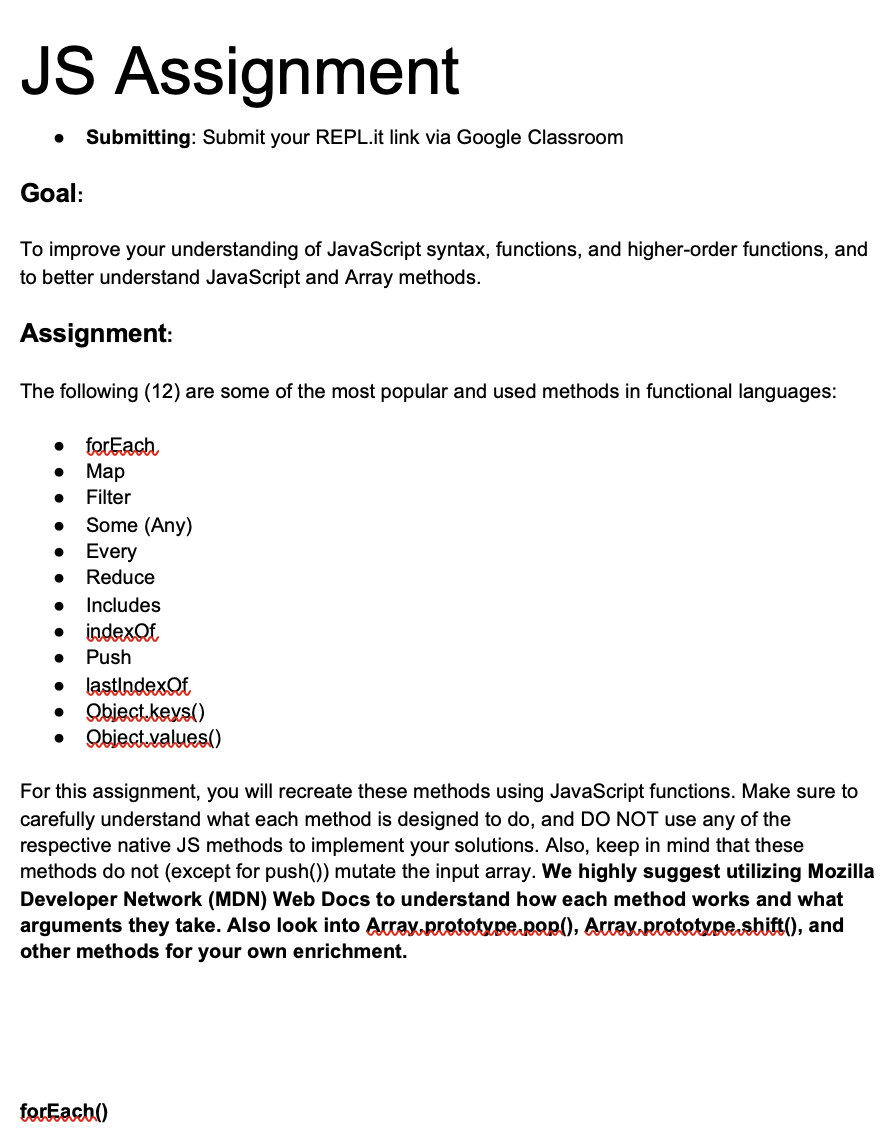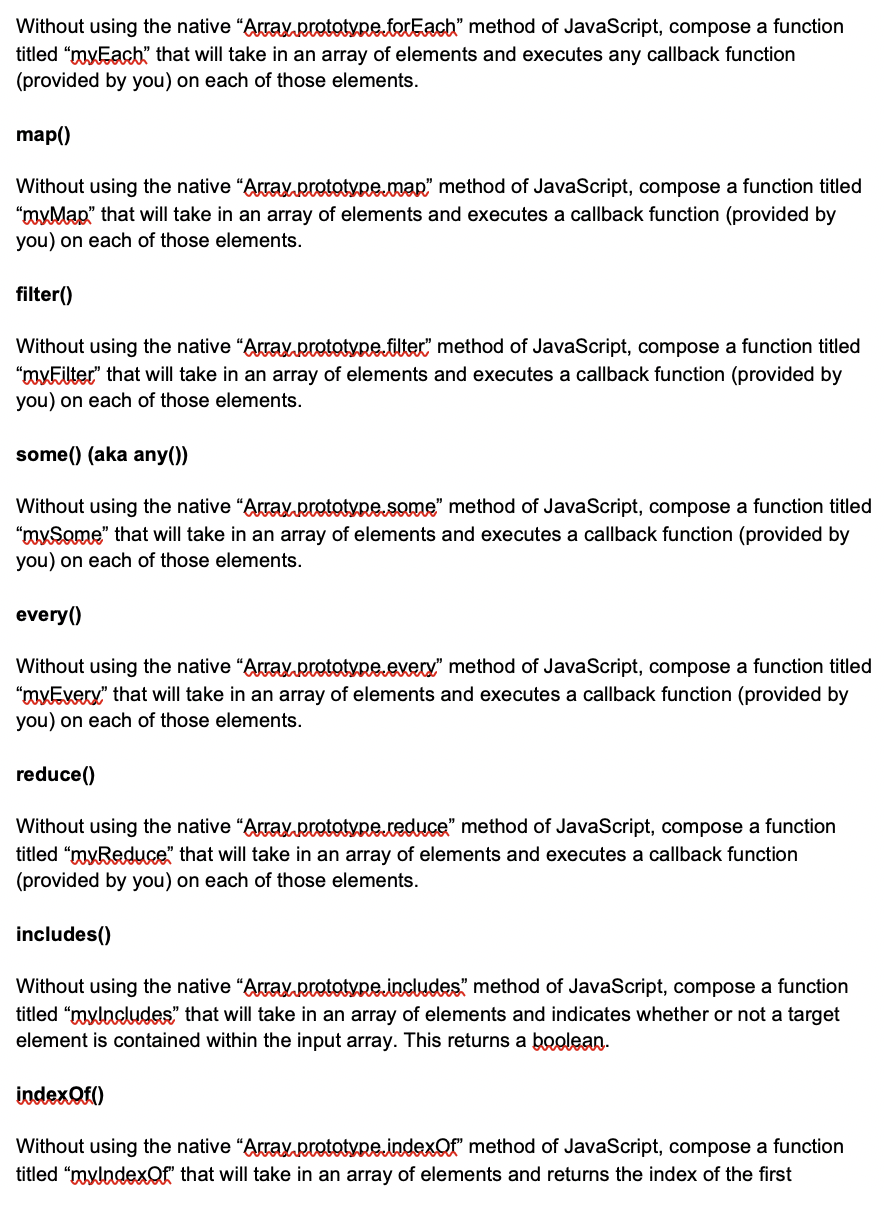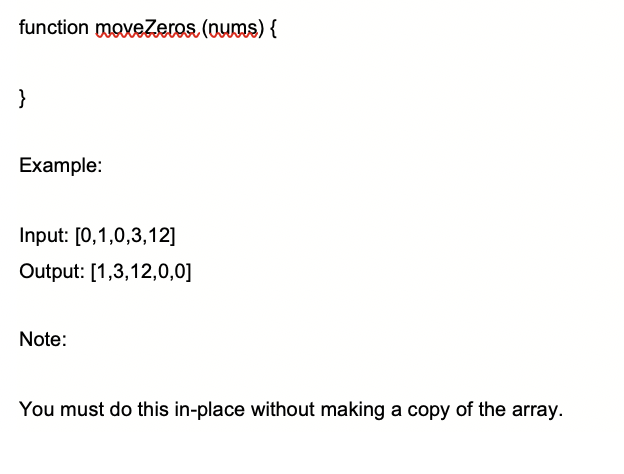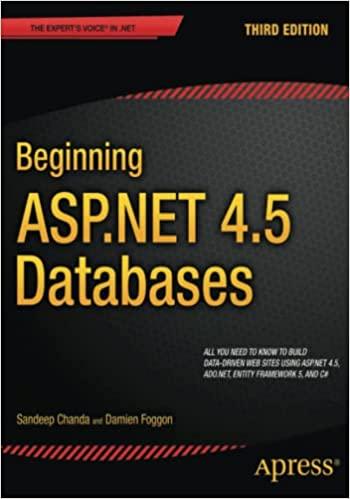



JS Assignment Submitting: Submit your REPL.it link via Google Classroom Goal: To improve your understanding of JavaScript syntax, functions, and higher-order functions, and to better understand JavaScript and Array methods. Assignment: The following (12) are some of the most popular and used methods in functional languages: 0 . 0 forEach Map Filter Some (Any) Every Reduce Includes indexOf Push lastIndexOf Object.keys() Object.values() . . . For this assignment, you will recreate these methods using JavaScript functions. Make sure to carefully understand what each method is designed to do, and DO NOT use any of the respective native JS methods to implement your solutions. Also, keep in mind that these methods do not (except for push()) mutate the input array. We highly suggest utilizing Mozilla Developer Network (MDN) Web Docs to understand how each method works and what arguments they take. Also look into Array.prototype.pop(), Array.prototype shift(), and other methods for your own enrichment. forEach() Without using the native Array prototype.forEach" method of JavaScript, compose a function titled moxEach" that will take in an array of elements and executes any callback function (provided by you) on each of those elements. map() Without using the native Array prototype.man" method of JavaScript, compose a function titled "mox Map" that will take in an array of elements and executes a callback function (provided by you) on each of those elements. filter() Without using the native Array prototype.filter" method of JavaScript, compose a function titled "moxFilter" that will take in an array of elements and executes a callback function (provided by you) on each of those elements. some() (aka any() Without using the native Array prototype some" method of JavaScript, compose a function titled "maxSome" that will take in an array of elements and executes a callback function (provided by you) on each of those elements. every() Without using the native Array.prototype.every" method of JavaScript, compose a function titled "mox Execy" that will take in an array of elements and executes a callback function (provided by you) on each of those elements. reduce() Without using the native Array.prototype.seduce" method of JavaScript, compose a function titled moxReduce" that will take in an array of elements and executes a callback function (provided by you) on each of those elements. includes() Without using the native "Array.prototype.includes" method of JavaScript, compose a function titled movlncludes" that will take in an array of elements and indicates whether or not a target element is contained within the input array. This returns a boolean. indexOf() Without using the native Array.prototype.indexOf" method of JavaScript, compose a function titled "moxlndexOf" that will take in an array of elements and returns the index of the first encounter of a target element (if it is found) or -1 if that element does not exist within the input array. push() Without using the native Array prototype.pusb" method of JavaScript, compose a function title "maxRush" that will take in an array of elements as well as an elementToAdd and append that element to the end of the array. lastlndexOf) Without using the native Array.prototype.lastIndexOf" method of JavaScript, compose a function titled "myUnshift" (typo) that will take in an array of elements and returns the index of the last encounter of a target element (if it is found) or -1 if that element does not exist within th input array. Qbiect kekso Without using the native "Object keys()" method of JavaScript, compose a function titled "grab Keys" that will take in an object and return all of the keys of the key value pairs of that object. Modify the Object class, appending a static method to the Object class., appending a static method to the Object class. Leverage the for...in loop. Obiect.xalues0 Without using the native "Object values()" method of JavaScript, compose a function titled "grabValues" that will take in an object and return all of the values of the key value pairs of that object. Modify the Object class, appending a static method to the Object class. Leverage the "for...in" loop. Miscellaneous Problems (4) From Chapter 4 of Eloquent JavaScript . . Sum of a Range Reversing an Array A List Deep Comparison . . Miscellaneous Problems (1) 1: Given an array nums, write a function to move all O's to the end of it while maintaining the relative order of the non-zero elements. function moveZeros (oums) { } Example: Input: [0,1,0,3,12] Output: (1,3,12,0,0] Note: You must do this in-place without making a copy of the array. JS Assignment Submitting: Submit your REPL.it link via Google Classroom Goal: To improve your understanding of JavaScript syntax, functions, and higher-order functions, and to better understand JavaScript and Array methods. Assignment: The following (12) are some of the most popular and used methods in functional languages: 0 . 0 forEach Map Filter Some (Any) Every Reduce Includes indexOf Push lastIndexOf Object.keys() Object.values() . . . For this assignment, you will recreate these methods using JavaScript functions. Make sure to carefully understand what each method is designed to do, and DO NOT use any of the respective native JS methods to implement your solutions. Also, keep in mind that these methods do not (except for push()) mutate the input array. We highly suggest utilizing Mozilla Developer Network (MDN) Web Docs to understand how each method works and what arguments they take. Also look into Array.prototype.pop(), Array.prototype shift(), and other methods for your own enrichment. forEach() Without using the native Array prototype.forEach" method of JavaScript, compose a function titled moxEach" that will take in an array of elements and executes any callback function (provided by you) on each of those elements. map() Without using the native Array prototype.man" method of JavaScript, compose a function titled "mox Map" that will take in an array of elements and executes a callback function (provided by you) on each of those elements. filter() Without using the native Array prototype.filter" method of JavaScript, compose a function titled "moxFilter" that will take in an array of elements and executes a callback function (provided by you) on each of those elements. some() (aka any() Without using the native Array prototype some" method of JavaScript, compose a function titled "maxSome" that will take in an array of elements and executes a callback function (provided by you) on each of those elements. every() Without using the native Array.prototype.every" method of JavaScript, compose a function titled "mox Execy" that will take in an array of elements and executes a callback function (provided by you) on each of those elements. reduce() Without using the native Array.prototype.seduce" method of JavaScript, compose a function titled moxReduce" that will take in an array of elements and executes a callback function (provided by you) on each of those elements. includes() Without using the native "Array.prototype.includes" method of JavaScript, compose a function titled movlncludes" that will take in an array of elements and indicates whether or not a target element is contained within the input array. This returns a boolean. indexOf() Without using the native Array.prototype.indexOf" method of JavaScript, compose a function titled "moxlndexOf" that will take in an array of elements and returns the index of the first encounter of a target element (if it is found) or -1 if that element does not exist within the input array. push() Without using the native Array prototype.pusb" method of JavaScript, compose a function title "maxRush" that will take in an array of elements as well as an elementToAdd and append that element to the end of the array. lastlndexOf) Without using the native Array.prototype.lastIndexOf" method of JavaScript, compose a function titled "myUnshift" (typo) that will take in an array of elements and returns the index of the last encounter of a target element (if it is found) or -1 if that element does not exist within th input array. Qbiect kekso Without using the native "Object keys()" method of JavaScript, compose a function titled "grab Keys" that will take in an object and return all of the keys of the key value pairs of that object. Modify the Object class, appending a static method to the Object class., appending a static method to the Object class. Leverage the for...in loop. Obiect.xalues0 Without using the native "Object values()" method of JavaScript, compose a function titled "grabValues" that will take in an object and return all of the values of the key value pairs of that object. Modify the Object class, appending a static method to the Object class. Leverage the "for...in" loop. Miscellaneous Problems (4) From Chapter 4 of Eloquent JavaScript . . Sum of a Range Reversing an Array A List Deep Comparison . . Miscellaneous Problems (1) 1: Given an array nums, write a function to move all O's to the end of it while maintaining the relative order of the non-zero elements. function moveZeros (oums) { } Example: Input: [0,1,0,3,12] Output: (1,3,12,0,0] Note: You must do this in-place without making a copy of the array










